No knight is complete without a suit of armor, his weapon, and of course, his Steed. Legends usually describe heroes coming at the last minute or going to the source of trouble. A few examples would be the riders of Rohan or the legendary horse Shadowfax.
I have tried and used various methods to keep this spell feeling fresh over the years, from summoning different creatures to bringing around equipment for the creatures called by this spell, from the ones recommended by the spell to a few others that I have had many discussions with different DMs on if an alternative was possible.
Join us in this Find Steed 5e guide and let’s take a look at everything you need to know about this conjuration spell.
Finding a Steed (Shortcut)
This is a 2nd level spell only accessible to Paladins. Here are what you need to know when casting this spell.
| Casting time | 10 Minutes |
| Range | 30 ft |
| Target | Unoccupied area within range |
| Components | Verbal & Somatic |
| Duration | Instantaneous |
Effects:
- Creates a steed (Pony, Warhorse, Camel, Elk, Mastiff, DM approved)
- It turns into a celestial, fey, or fiend
- The same Steed can be resummoned if dismissed or killed by casting this spell again.
- The caster can communicate with the Steed telepathically within one mile.
- While mounted, spells used by the caster that target himself can also target the Steed.
The Process (Long Version)
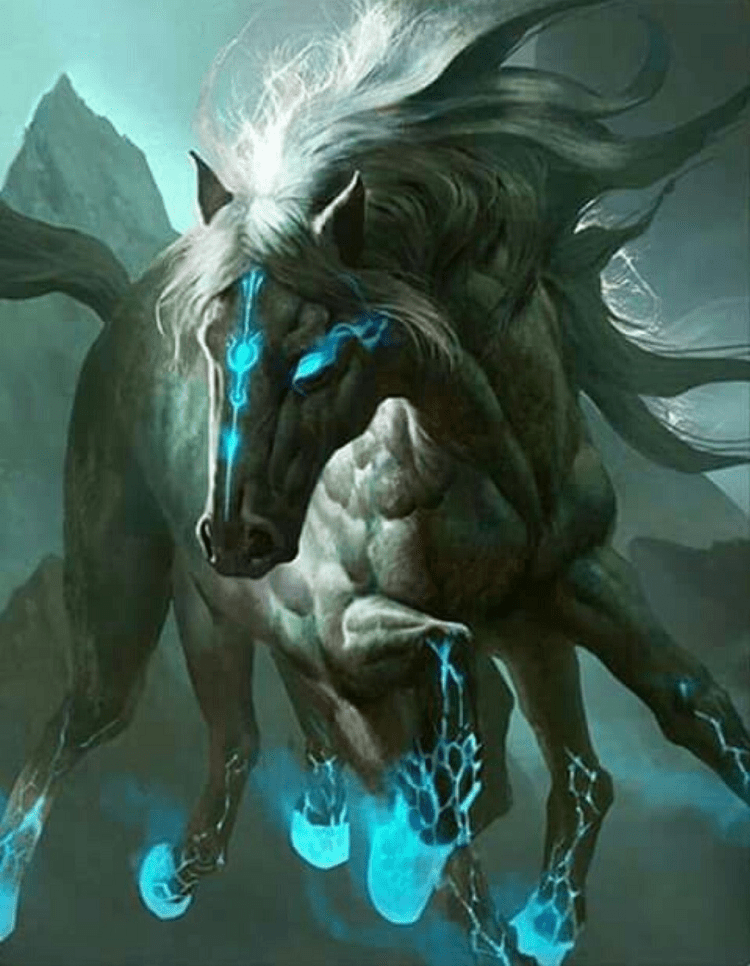
Let’s break down this spell to explain each part in greater detail.
Summon a Steed
As the spell suggests, this spell summons an animal you can ride on. It can be a Warhorse, pony, camel, elk, or mastiff. Additionally, the DM can approve a steed if it is not on this list.
The Steed will have a long-lasting bond with you as if you have been with it for years. The Steed does not leave any physical residue or materials behind if it is killed or dismissed.
As an action, the caster may dismiss the Steed causing it to disappear. You may resummon the Steed by recasting this spell.
Even if you change the form of the Steed, you will always resummon the same Steed. This means that even if you summoned a warhorse the first time, then an elk the second, it will be the same creature, just in a new form.
Steed Stats
The creature summoned has the same stats as usual, so ask your DM if you can look at the Monster Manual for the stat block of the beast you are calling.
However, it does change the Intelligence stat of the creature to six if it is less than six. It gives the steed understanding of one language that the caster knows.
While some creatures are more combat-oriented, others are more for travel and movement, so try and balance the utility of the Steed with its combat effectiveness.
Things You Can Do with the Steed
While using the Steed, you can do a variety of things. If it’s within one mile of you, you can communicate telepathically. This allows you to give it orders non-verbally, and even when you are far away, it could do things that you need, whether getting help or causing a distraction.
While mounted on the Steed, spells that you cast, which target yourself, can be extended to cast on your Steed. Meaning spells such as Shield of Faith or Misty step would affect both of you rather than just yourself.
In the next section, I will list down the spells you can cast on yourself and your Steed.
Steed Spells
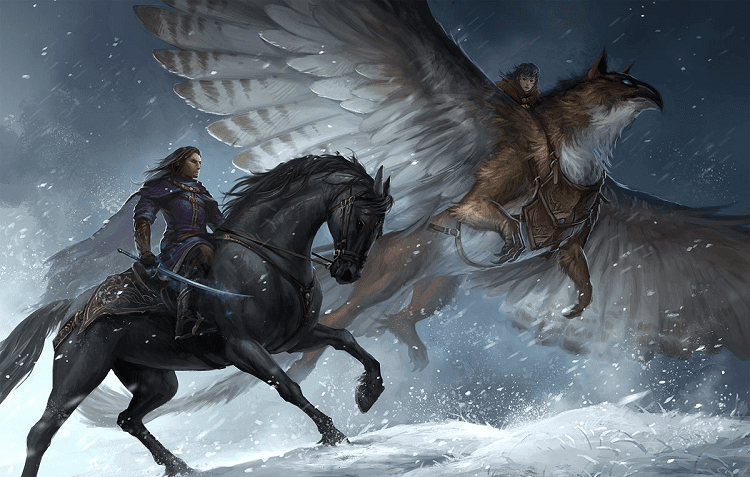
These are all spells that a Paladin can cast; I will not consider multiclassing because that would involve over a few hundred spells total.
Note that these spells target you, not spells with a range of “self” this means that auras are out of the question even if they target self since their effects extend to other characters. This includes harmful spells that allow you to choose a target since it will extend to your Mount if you choose yourself.
A note about this list: all the detects and smite spells function similarly, so I will only add the description to the first few and leave the rest blank.
Also, the Detect spells all have the same limitation of the detection area, so if you cast it on yourself and your Steed, you would both be detected in the same area, providing no further benefit.
Level 1 Spells
- Armor of Agathys (Temporary HP and reciprocal damage dealing)
- Cure Wounds (Healing)
- Detect Evil and Good (Let’s you sense Evil and Good creature)
- Detect Magic (Let’s you sense magic)
- Detect Poison and Disease (Like above but with Poison and diseases)
- Divine Favour (Weapon-specific buff, technically does not affect mounts)
- Heroism ( Temporary HP and Fear immunity)
- Protection from Evil and Good (Defensive buff against Evil or Good Creatures)
- Sanctuary (Defensive buff against attacks)
- Speak with Animals (Kind of useless but lets you talk to low-intelligence animals)
- Searing Smite (Weapon buff that wears off after one usage, even between both targets)
- Shield of Faith (AC increasing buff)
- Thunderous Smite
- Wrathful Smite
Level 2 Spells
- Aid (Temporary Max HP increase)
- Branding Smite
- Lesser Restoration (Cleanse of minor ailments)
- Locate Objects (Same limitations as Detect spells)
- Misty Step (Movement spell)
- Protection from Poison (defensive buff against poison and poison damage)
Level 3 Spells
- Blinding Smite
- Dispel Magic (disrupts Magic)
- Elemental Weapon (Weapon buff, technically does not work with mounts)
- Haste (Action and movement speed buff)
- Protection from Energy (Defensive buff against specific elemental damage)
- Remove Curse (Cleanses curses)
Level 4 Spells
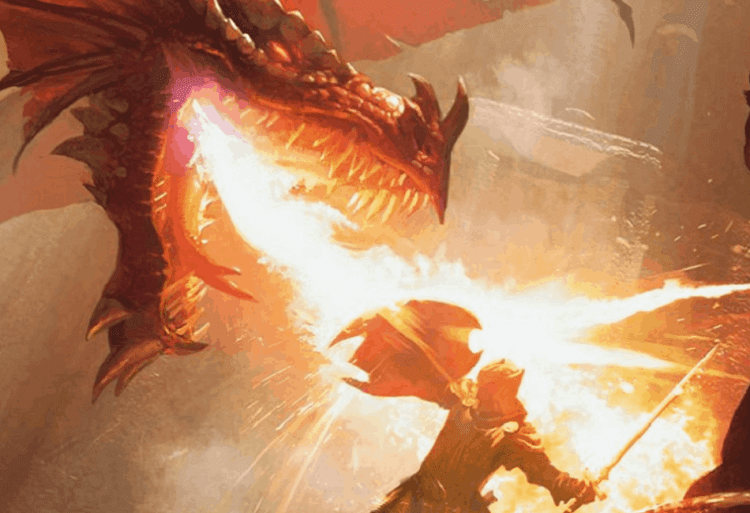
- Banishment (Movement sort of, Would not recommend casting on self)
- Death Ward (Protection against death once per use)
- Freedom of Movement (Ignores move speed, slows, and restraints)
- Locate Creature (Find a creature)
- Otiluke’s Resilient Sphere (Protection sort of, more like a trapping spell)
- Staggering Smite
- Stoneskin (Increase natural AC, does not affect armor)
Level 5 Spells
- Commune (Asking God for Help)
- Commune with Nature (asking Nature for Info)
- Dispel Evil and Good (Anti-Celestial, Fey, or Fiend)
- Holy Weapon (Weapon buff, again, technically does not work with Mount)
- Scrying (Scouting spell)
- Tree Stride (Move great distances)
Boy, that was a lot of spells, and only from the Paladin spell list; the spells diversify further if you include multiclassing, so keep in mind that it only works if the spell targets only you and no one else.
List of Steeds
Here is a list of possible steeds and a few that are not on the list. In it, I will also put down the important stats and attacks they have, and I will mark those not on the original list in case you need to ask your DM if it is alright to summon this kind of Steed.
Warhorse
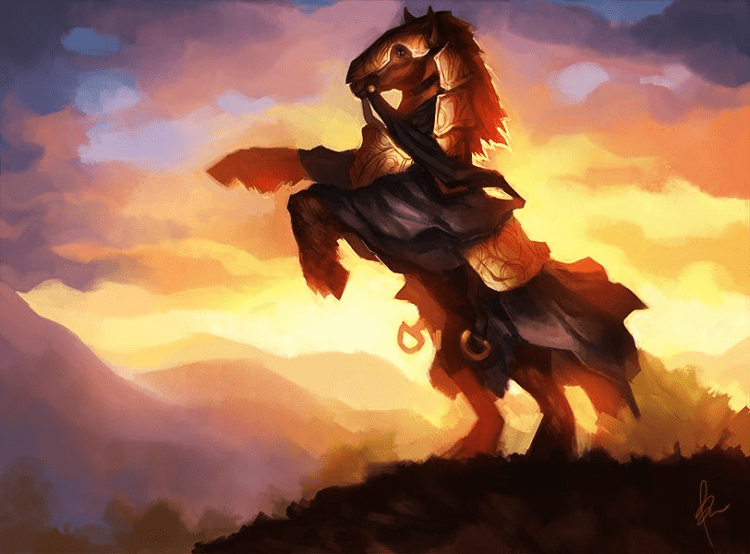
I recommend this creature; not only is it the most powerful on the original list, but it is also one of the most useful.
Stats-wise, it has
- 60 speed
- 19 HP
- 11 AC
- 18 Strength
- 12 Dexterity
- 13 Constitution
- 2 Intelligence
- 12 Wisdom
- 7 Charisma
- Charge attack that potentially knocks the target prone
- Hooves attack
It lets you move around the battlefield quickly and can carry quite a heavy burden due to its high Strength score. It also helps that as a Warhorse; it can defend itself with its trample and hoof attack combo.
Pony
Slightly weaker than the Warhorse but still works as a mount.
- 40 Speed
- 11 HP
- 10 AC
- 15 Strength
- 10 Dexterity
- 13 Constitution
- 2 Intelligence
- 11 Wisdom
- 7 Charisma
- Hooves attack
Weaker than the Warhorse but also less likely to be targeted. It also doubles as a great pack mule.
Camel
A more desert-oriented mount when trying to blend in.
- 50 Speed
- 15 HP
- 9 AC
- 16 Strength
- 8 Dexterity
- 14 Constitution
- 2 Intelligence
- 8 Wisdom
- 5 Charisma
- Bite attack
It is about as strong as a Pony and lacks the hooves’ attack.
Elk

This is also a creature I recommend second to the Warhorse. It is unique, albeit slightly weaker than the Warhorse.
- 50 Speed
- 13 HP
- 10 AC
- 16 Strength
- 10 Dexterity
- 12 Constitution
- 2 Intelligence
- 10 Wisdom
- 6 Charisma
- Charge attack
- Ram attack
- Hooves Attack
Like the Warhorse, this creature can knock someone down with its charge attack before running over it with its hooves; it is slightly weaker than the Warhorse considering its AC and health.
Mastiff
This is for the small-sized player to use as a mount. Riding on a medium-sized dog seems to fit as if a small gnome was on top of it.
- 40 Speed
- 5 HP
- 12 AC
- 13 Strength
- 14 Dexterity
- 12 Constitution
- 3 Intelligence
- 12 Wisdom
- 7 Charisma
- Bite attack
- Keen Hearing and Smell
It’s weak compared to a warhorse but has perception skills, unlike the other mounts. It could prove to be valuable in a party needing another scout.
Axebeak (Not OG)
While this is not on the original list, I believe it is a fair mount to use since it has no special abilities and is close to a massive Ostrich in shape, and the shape allows for it to be ridden.
- 50 Speed
- 19 HP
- 11 AC
- 14 Strength
- 12 Dexterity
- 12 Constitution
- 2 Intelligence
- 10 Wisdom
- 5 Charisma
- Beak attack
It hits weaker but makes up for it with slightly higher health.
Worg (Not OG)

This would be the creature I recommend if your DM approves of it. While it is evil in Nature, it is as powerful as a warhorse but also has a powerful perception skill with its dark vision, keen hearing, and smell abilities.
- 50 Speed
- 26 HP
- 13 AC
- 16 Strength
- 13 Dexterity
- 13 Constitution
- 7 Intelligence
- 11 Wisdom
- 8 Charisma
- Bite attack
Its bite attack has a chance of knocking a creature prone on top of its damage; while it cannot make consecutive attacks, it still sets up for its rider to attack with an advantage.
Giant Goat (Not OG)
This is a funny creature to be riding seen more in scenes like Lord of the Rings than in other fantasy movies. Its looks are deceiving, however, as it is a powerful mount.
- 40 Speed
- 19 HP
- 11 AC
- 17 Strength
- 11 Dexterity
- 12 Constitution
- 3 Intelligence
- 12 Wisdom
- 6 Charisma
- Ram attack
- Charge Attack
It can knock creatures prone, ram them with its horns, and even have an advantage against effects that would knock it prone. It’s great in a duel against other mounts since they do not have this protection.
Riding Horse (Not OG)
It did not make sense to me that they added the Warhorse and did not add its weaker variants, so here is one of them, the riding horse.
- 60 Speed
- 13 HP
- 10 AC
- 16 Strength
- 10 Dexterity
- 12 Constitution
- 2 Intelligence
- 11 Wisdom
- 7 Charisma
- Hooves attack
Since this creature was not trained for combat, it is slightly weaker than the Warhorse, but still something I believe should be on the original list of summonable steeds.
Why Use this Spell
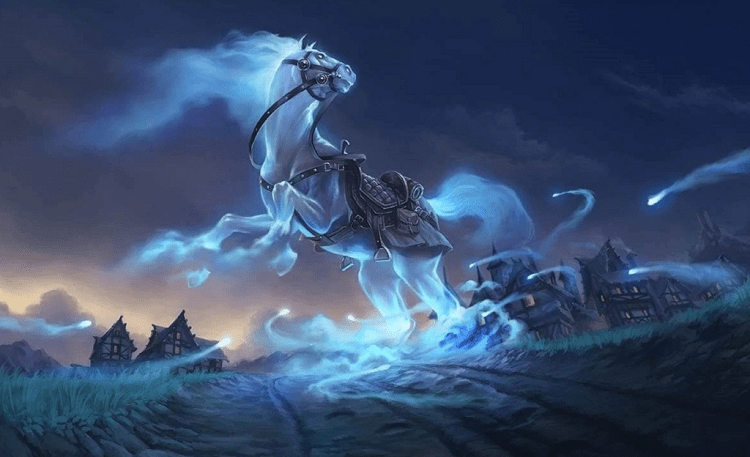
It is a free steed that will never truly expire, is intelligent enough to understand simple commands, and can communicate telepathically.
It makes a normal Paladin have a massive increase in movement speed and gives them the possibility that their target is knocked prone, which gives them the advantage to attacking.
Not only is the Steed an additional body to protect you, but it also adds a layer of creativity you can use when you are separated from the Steed. Additionally, it is easier to protect than a normal steed since the spells you cast on yourself are also applied to the Mount.
What Pairs Well with this Spell
Not too many things combo specifically with this spell as it is generally used to give an overall increase in combat capability rather than a niche but greater boost. However, two features are empowered while on an easy-to-access Mount.
The feat mounted combatant gives you an advantage when attacking a creature smaller than your Mount; this is a permanent source of advantage as Large creatures are rare to get outsized.
You can force attacks that target your Mount to hit you to preserve its low hitpoint count, and you give your mount Evasion against dexterity saving throws making it even harder to kill.
The Cavalier subclass is a fighter subclass that revolves around mounted combat focusing on control and tanking for your party. Combine that with a free mount that can be buffed simultaneously, making it even harder to kill while still forcing enemies to attack you.
The other thing that pairs well with it is Flanking or Pack Tactics and features like it, such as Sneak Attack. Since the Mount is considered another creature within five feet, it simultaneously enables all of these features semi-permanently. It will only stop when your Mount dies.
FAQs
Question: Do You Need a Saddle for Find Steed?
ANSWER: No, you do not. The spell allows you to ride them as if you had been with them for years; a special bond is formed between you and your steed the moment this spell is cast.
QUESTION: CAN FIND STEED SUMMON A FLYING MOUNT?
ANSWER: No. It would break the game’s balance and make find greater steed’s spell pointless.
QUESTION: DO THE MOUNTS FROM FIND STEED NEED FOOD?
ANSWER: No, they do not. The mounts created are spirits and do not need food, water, or sleep
Find Steed 5e Guide: Final Thoughts
Since Paladins cannot ritual cast, you will always need to use a spell slot to find your Steed; however, so long as the Steed does not die, it is a permanent mount after the first casting.
You can even choose to armor your Steed to make it even harder to kill. It’s a powerful spell; it does not need any investment to become usable and will even shine if an investment is put into it. It is a strong spell for its level and exclusive to Paladins, so give it a shot!
- Prestige Classes 5e Guide - September 20, 2022
- Rod of the Pact Keeper 5e Guide - September 15, 2022
- Sanctuary 5e Guide - September 14, 2022

